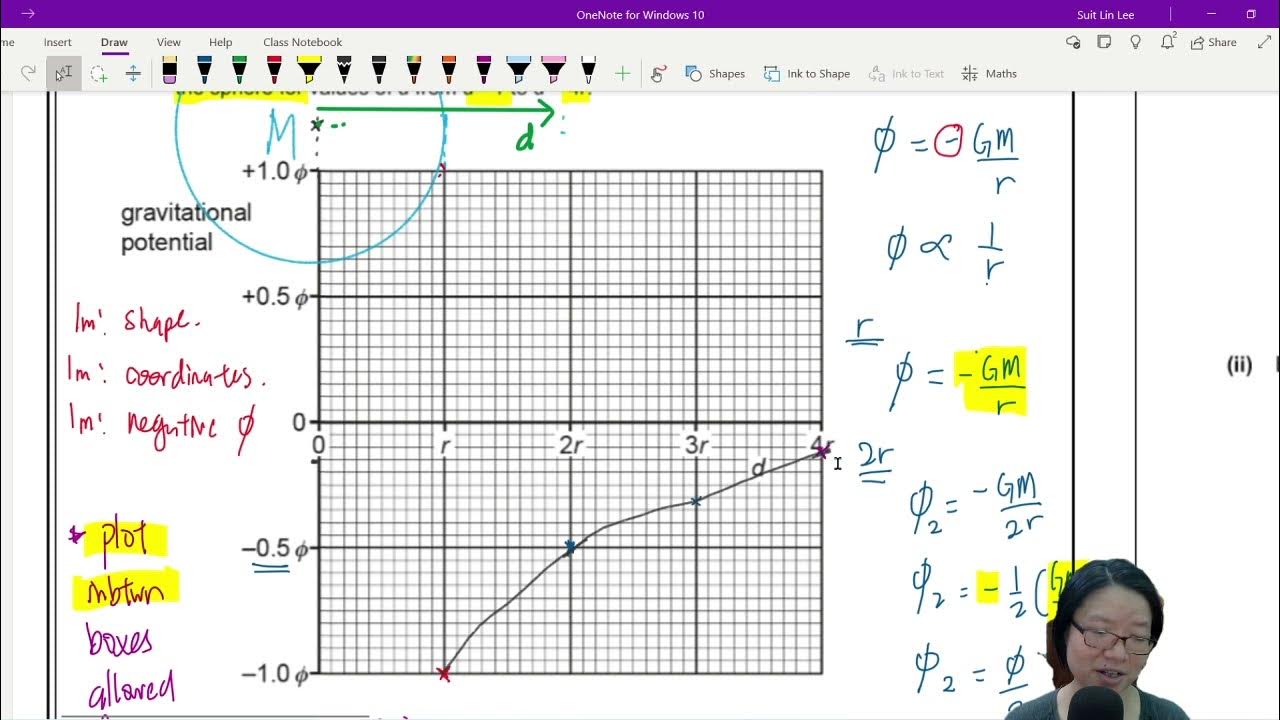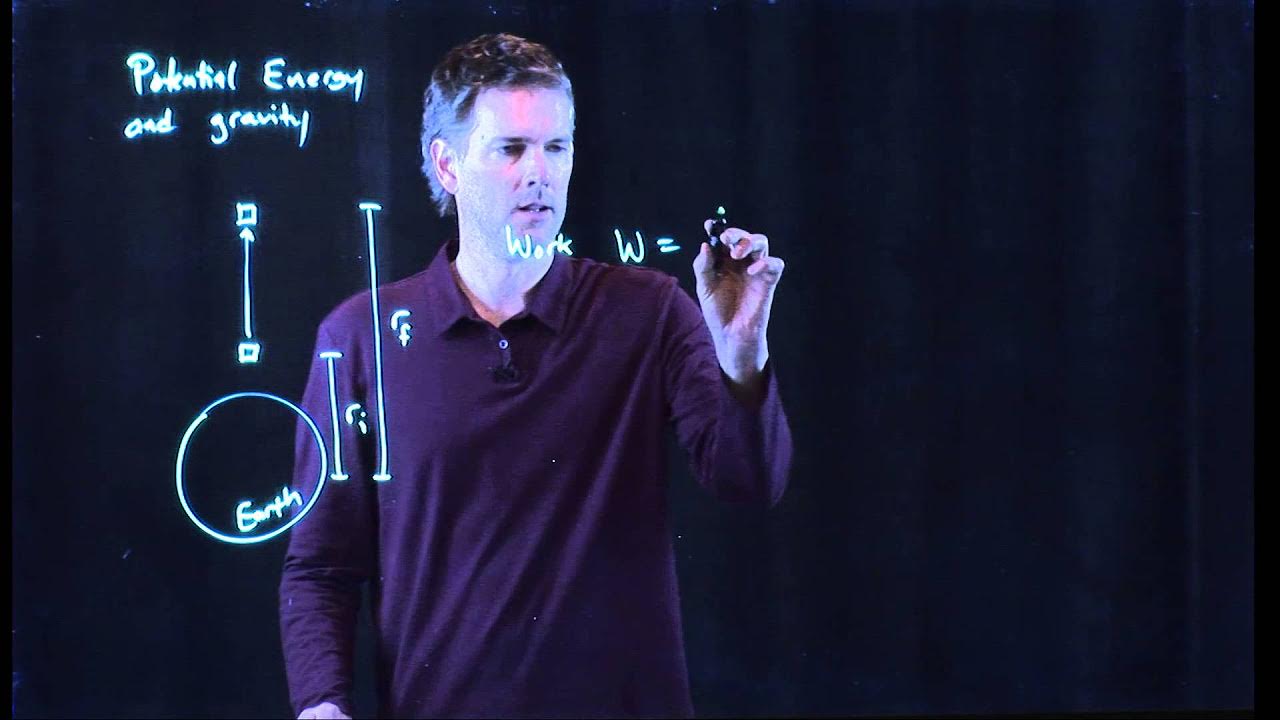Why is Gravitational Potential Energy Negative? (Gravity, Physics)
TLDRThe video script delves into the concept of gravitational potential energy and its inherent negativity, explaining the relationship between work, energy transfer, and gravitational force. It illustrates how the potential energy of a system is negative when two masses are in gravitational interaction, as work is required to separate them against the attractive force. The video also extends the discussion to electric charges, highlighting that the potential energy's sign corresponds to the nature of interactions—negative for attractive forces and positive for repulsive ones. The explanation is aimed at high school physics students, encouraging engagement and further inquiry.
Takeaways
- 🌌 Gravitational potential is the gravitational potential energy per unit mass, indicating that gravitational potential and gravitational potential energy share the same sign.
- 🔄 The concept of work in physics is a transfer of energy, which is crucial to understanding changes in a system's energy.
- 📉 Gravitational potential energy is always negative when two masses are in gravitational interaction because the gravitational force between them is attractive.
- 🚀 To increase the distance between two masses in a gravitational interaction, work must be done against the attractive force, which increases the system's potential energy.
- ∞ At infinite separation (or a very large distance), the gravitational force and potential energy between two masses is zero.
- 🔧 The mathematical expression for gravitational potential energy between two masses is directly proportional to the product of their masses and inversely proportional to the distance between them.
- 📌 The negative sign in the equation for gravitational potential energy arises because the potential energy is zero at an infinite distance and becomes negative as the distance decreases due to the work done to bring the masses closer.
- 🔄 For electric charges, the potential energy can be negative, zero, or positive depending on whether the charges are attractive (opposite signs), repulsive (same sign), or infinitely far apart, respectively.
- 👉 The sign of potential energy in a system (gravitational or electrical) is directly related to the nature of the interaction: attractive interactions result in negative potential energy, while repulsive interactions result in positive potential energy.
- 📈 The potential energy of a system can be determined by calculating the work done to move a mass from one position to another against the force of interaction.
- 🤔 Understanding the relationship between potential energy and the interactions within a system is essential for grasping fundamental concepts in physics.
Q & A
What is gravitational potential?
-Gravitational potential is the gravitational potential energy per unit mass, representing the energy state of an object in a gravitational field.
Why is gravitational potential energy always negative?
-Gravitational potential energy is always negative when two masses are in gravitational interaction because it takes work to separate them against the attractive gravitational force, which increases the potential energy to reach a reference state where the distance is infinite, where potential energy is zero.
How is work related to energy transfer?
-Work is a measure of energy transfer. When work is done on a system, it changes the system's energy, with the change in energy being equal to the work performed.
What is the relationship between gravitational potential energy and the distance between two masses?
-The gravitational potential energy of a system of two masses is inversely related to the distance between them. As the distance increases, the gravitational potential energy of the system becomes more positive (less negative), and as the distance decreases, it becomes more negative.
What is the mathematical expression for gravitational potential energy between two masses?
-The gravitational potential energy (U) between two masses (m1 and m2) is given by the formula U = -G * (m1 * m2) / r, where G is the gravitational constant and r is the distance between the centers of the two masses.
How does the sign of potential energy relate to the nature of interactions within a system?
-If the interaction is attractive, the potential energy is negative; if the interaction is repulsive, the potential energy is positive. A potential energy of zero indicates no interaction, as the objects are infinitely far apart.
What happens to the gravitational potential energy when the distance between two masses approaches infinity?
-When the distance between two masses approaches infinity, the gravitational force—and consequently the gravitational potential energy—approaches zero, as the force is inversely proportional to the square of the distance.
How does the concept of work help explain the negativity of gravitational potential energy?
-The concept of work explains that doing work on a system (like separating two masses) requires energy input, which increases the system's potential energy. Since gravitational interactions are attractive, work must be done to overcome this attraction, leading to negative gravitational potential energy.
What is the work done to increase the distance between two gravitationally interacting masses?
-The work done to increase the distance between two gravitationally interacting masses is equal to the change in their gravitational potential energy. This work is positive because it is done against the attractive gravitational force, which results in an increase in potential energy.
How does the gravitational potential energy change when a mass is brought from infinity to a finite distance in a gravitational field?
-When a mass is brought from infinity to a finite distance in a gravitational field, work must be done against the gravitational force, which increases the gravitational potential energy of the system. This results in a negative value for the potential energy because work is required to reach the finite distance from the reference state of infinite separation.
What is the significance of the negative sign in the expression for gravitational potential energy?
-The negative sign in the expression for gravitational potential energy indicates that the energy is stored in the system due to the attractive nature of gravity. It reflects the fact that work was done to bring the two masses from an infinite distance, where the potential energy is zero, to a closer distance where they exert a gravitational pull on each other.
Outlines
🌌 Understanding Gravitational Potential Energy
This paragraph introduces the concept of gravitational potential energy and its relationship with gravitational potential. It explains that gravitational potential energy is always negative due to the attractive nature of gravitational forces. The video aims to clarify why the potential energy associated with gravity is negative by using the analogy of a planet and a moon in gravitational interaction. The concept of work in physics is also briefly reviewed, emphasizing that work is a transfer of energy which changes the energy state of a system. The explanation is grounded in the idea that to separate two masses against gravitational attraction, work must be done, which increases the potential energy of the system, thus starting from a negative value when the masses are in proximity.
🔧 Calculating Gravitational Potential Energy
The second paragraph delves into the mathematical aspect of calculating gravitational potential energy. It describes a thought experiment where the gravitational force between two masses is considered, and the work done to change their distance is calculated. The paragraph explains that when a mass is moved from an infinite distance (where gravitational force and potential energy are zero) to a closer distance 'r', work is done against the gravitational force, which increases the potential energy. The integral of the work done, using the gravitational force formula, results in a negative value for the potential energy, confirming the initial assertion that gravitational potential energy is negative when masses are in proximity.
💡 The Significance of Potential Energy Signs
The final paragraph wraps up the discussion by summarizing the key points and extending the concept to other types of interactions, such as electrostatic forces. It emphasizes that the sign of potential energy (negative for attractive forces and positive for repulsive forces) is indicative of the nature of the interaction between objects. The paragraph also encourages viewers to ask more physics questions and engage with the content. The video concludes by highlighting the importance of understanding the sign of potential energy in relation to the interactions within a system and invites viewers to support the channel for more informative content.
Mindmap
Keywords
💡Gravitational Potential
💡Work
💡Gravitational Potential Energy
💡Gravitational Force
💡Energy Conservation
💡Displacement
💡Infinite Distance
💡Interaction
💡Electric Charges
💡Potential Energy
💡Attractive and Repulsive Interactions
Highlights
Gravitational potential is a concept related to gravitational potential energy per unit mass.
Gravitational potential energy is always negative when two masses are in gravitational interaction.
The concept of work in physics is a transfer of energy, which is fundamental to understanding changes in a system's energy.
The work done on a system is equal to the change in energy of that system.
Gravitational force is an attractive force between two masses, proportional to the product of their masses and inversely proportional to the square of the distance between them.
To increase the distance between two masses in gravitational interaction, work must be done, which costs energy, thus increasing the potential energy.
At infinite distance, the gravitational force and potential energy between two masses are zero.
The potential energy of a system is negative when the interaction is attractive, indicating that work must be done to overcome this attraction.
The mathematical expression for gravitational potential energy between two masses is proportional to the product of their masses and inversely proportional to the distance between them.
The negative sign in the gravitational potential energy equation arises from the need to do work against the attractive force to separate the masses.
The potential energy of a system with repulsive interactions, such as two like charges, is positive.
The sign of potential energy (negative for attractive interactions, positive for repulsive) reflects the nature of the interactions within the system.
The video provides a clear explanation of why gravitational potential energy is always negative, relating it to the fundamental concept of work in physics.
The video uses the analogy of a planet and a moon to explain gravitational interaction and potential energy, making the concepts more accessible.
The video encourages viewers to ask more high school physics questions in the comments for potential inclusion in future videos.
Transcripts
Browse More Related Video

MJ16 P41 Q1 Gravitational Potential Between 2 Stars | A2 G-fields | Cambridge A Level 9702 Physics

13.3a Gravitational Potential Theory | A2 G-Fields | Cambridge A Level Physics

13.3b Ex1 MJ20 P42 Q1 Rock Potential Energy | A2 Gravitational Fields | Cambridge A Level Physics

Mr Chua, can you explain the F=-dU/dx formula?

Potential energy and gravity

AP Physics Workbook 4.I Gravitational Potential Energy
5.0 / 5 (0 votes)
Thanks for rating: